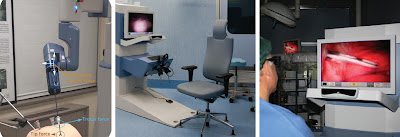Updates on the ALF-X system
Recently, I came a cross a new publication n the ALF-X system which revealed some more intereting details.
- "3 or 4 arms combined with 1 or 2 consoles, according to the needs. As the arms are separately moveable, immediate access to the patient is possible in case of an emerency.
- Fast docking: all instruments are connected to the arms with magnets - immediate exchange of needed instruments.
- The system detects within seconds the optimal pivot point of each inserted instrument.
- Cost-effectiveness: the surgeon can use low-cost disposable instruments, however, the system provides reusable instruents.
- Universality: any existing endoscopic instrument (articuated tip, monopolar, bipolar, laser etc. instruments) can be adapted. Therefore, surgeons do not have to change their operative habits and can even use the system for training.
- In the first experimental operations performed using the Telelap Alf-X, the average time for cholecystectomy was 31.75 min as compared to 91 min using a conventional telesurgical system (Cottineau et al, 1998). We strongly believe that haptic sensation provided more confidence to the surgeon, which explains the shorter operation time."
Last month, their logo and name became a registered Trade Mark.
Another JRC brochure tells more about the history of the system:
"In 2004, the Italian pharmaceutical company, SOFAR, first approached the Joint Research Centre. SOFAR’s research and development team wanted to explore how the JRC’s expertise in nuclear safeguard operations that had led to the development of unique software might be applied to the field of robotically assisted surgery. Four years of cooperation between JRC and SOFAR engineers led to the development of the first prototype of the Telelap ALF-X system. In parallel, the JRC filed three patent proposals and created innovative software pieces. These intellectual property assets were licensed to SOFAR for further developments in 2009."



Comments